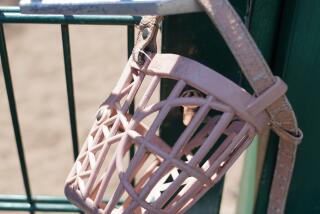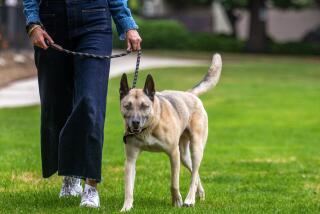Breed profiling
- Share via
Those doe-eyed, tail-wagging pooches waiting for new homes may be as loyal as any dog lover could want. But anyone planning to adopt or purchase a dog should beware: Fido or Fifi could be a killer when it comes to homeowner liability insurance.
Based on the dog-bite claims they see, insurers feel that some breeds are a poor risk. It’s a trend that began about 10 years ago, at around the same time as statistics were released showing that pit bulls, Rottweilers and German shepherds were responsible for more than half the dog bite fatalities in the U.S. over a 19-year period. Despite opposition from consumers, many insurance companies still maintain a will-not-cover breed blacklist. The list varies from company to company, according to Loraine Lacey, president of Independent Insurance Agents and Brokers of Orange County, depending on each company’s experience. But in the last few years, the lists have evolved to include:
Wolf hybrids
Akitas
American Bandogge Mastiffs
Boerboels
Chow-chows
Doberman pinschers
Olde English Bulldogs (English bulldogs are acceptable)
Rottweilers
Pit bull breeds, including American Staffordshire Terriers, English Bull Terriers, Pit Bull Terriers, Presa Canarios and Staffordshire Bull Terriers
Mixed breeds containing any of the above
“I don’t like it. It’s just wrong,” says attorney Jill Buckley, senior director of government relations and mediation for the American Society for the Prevention of Cruelty to Animals.
Many insurers may hike the premiums on a homeowner policy or decline to write a policy if the homeowner has what is considered a high-risk breed. But the ASPCA and defenders of some of the most stigmatized breeds, like pit bulls, say dog aggression is often more about owner behavior than breed temperament.
Aggression can be fostered in any breed and has been throughout history, as humans exploited the natural strength of certain breeds, Buckley says. In the middle ages, it was the Great Dane, bred and trained to defend the castle moats. The Newfoundland was the bad boy of the 1800s. Today it’s the pit bull.
“There’ll be another breed tomorrow. You can’t just keep banning breeds. You have to look at responsible ownership,” Buckley says.
Insurers should be more interested in knowing whether the owner has neutered and socialized the pet, Buckley says. For example, 70% of all dog-bite cases involve unsterilized male dogs, she says. Chained or tethered dogs are nearly three times more likely to bite than unchained dogs.
Lacey understands the resentment that lovers of those breeds may feel. Years ago her son had a pit bull that was a sweet family pet. On the other hand, some dogs may have aggressive personalities, no matter the breed or quality of human handling.
But in California, breed profiling by insurers is legal and a fact of dog life, says Tully Lehman, spokesman for the Insurance Information Institute.
So prospective dog owners might want to first find an insurer who can live with their breed of choice, Lehman says. Some companies will insure any breed until there’s a bite, after which renewal of liability coverage on the dog will be almost impossible regardless of breed. Others will insure any breed but require professional obedience training for some.
According to the Insurance Information Institute, dog bites cost insurers $356.2 million in 2007.
“That’s why it’s important that when you do have a dog you’re a responsible owner. If you raise a dog from a puppy, take it through training and socializing,” Lehman says. “Playing fetch is a great game. Wrestling and tug of war are not so great. That brings out the aggressive nature of dogs.”
Most of all, well-behaved dogs are important to the people most likely to be bitten -- children. Of the 4.7 million victims of dog bites in the U.S., more than half are children, according to the American Academy of Pediatrics.
But any dog can bite, and anyone can be a victim. Buckley knows that well. Her neighbor’s Lhasa apso bit her.
“It tore right into my ankle. As I’ve said, it’s not the breed of the dog.”
--
More to Read
Sign up for Essential California
The most important California stories and recommendations in your inbox every morning.
You may occasionally receive promotional content from the Los Angeles Times.










